Unit1What'sthematter-SectionB2bReading课文知识点串讲课件(共16张PPT)
文档属性
| 名称 | Unit1What'sthematter-SectionB2bReading课文知识点串讲课件(共16张PPT) |  | |
| 格式 | zip | ||
| 文件大小 | 851.3KB | ||
| 资源类型 | 教案 | ||
| 版本资源 | 人教新目标(Go for it)版 | ||
| 科目 | 英语 | ||
| 更新时间 | 2022-01-17 17:33:25 | ||
图片预览

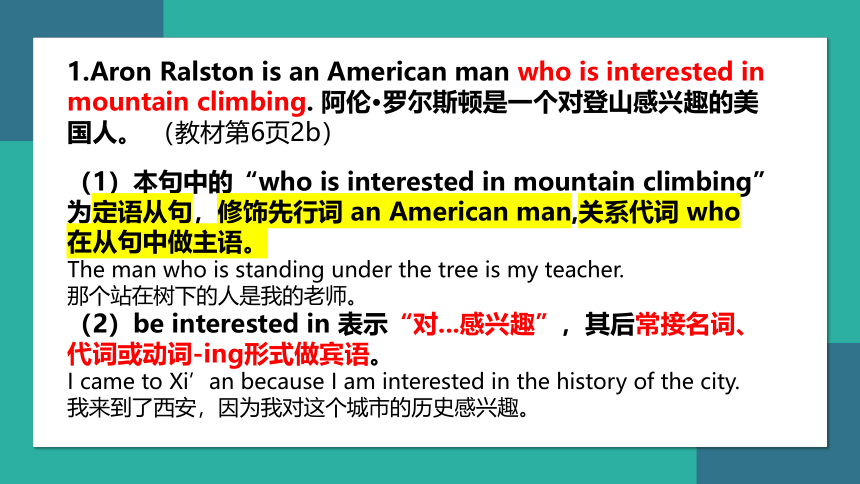
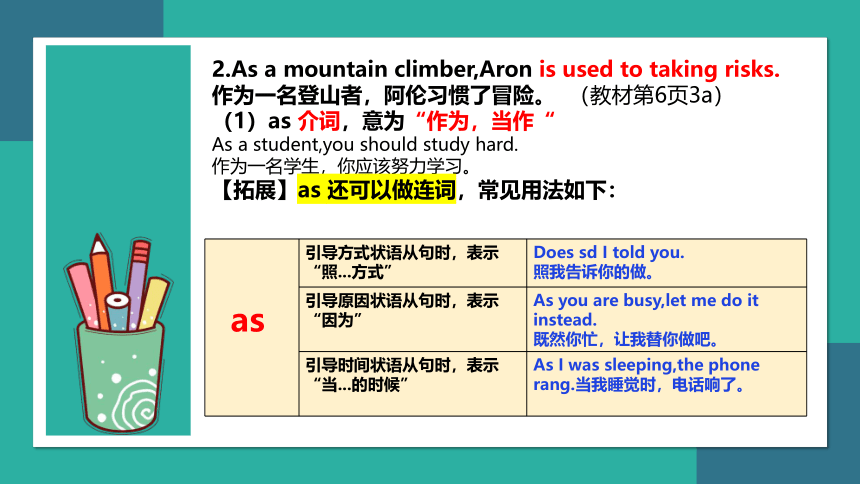

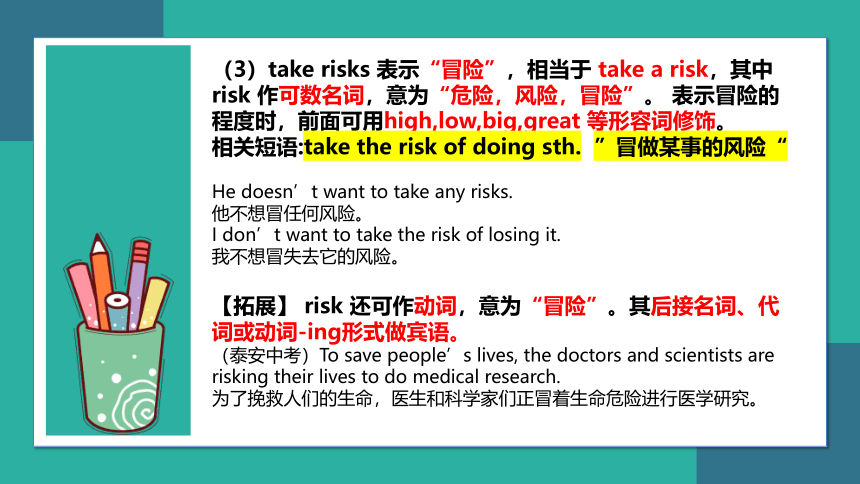
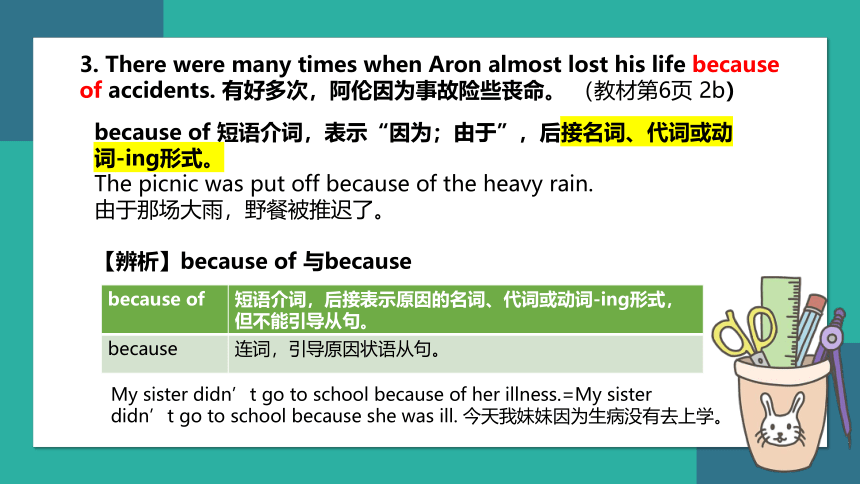
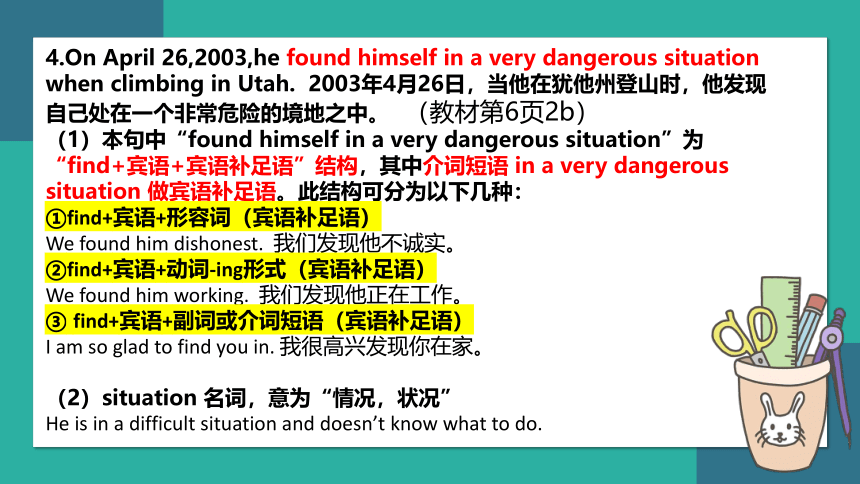
文档简介
(共16张PPT)
Unit 1 What's the matter
Section B 2b reading课文知识点归纳
1.Aron Ralston is an American man who is interested in mountain climbing. 阿伦 罗尔斯顿是一个对登山感兴趣的美国人。 (教材第6页2b)
(1)本句中的“who is interested in mountain climbing”为定语从句,修饰先行词 an American man,关系代词 who 在从句中做主语。
The man who is standing under the tree is my teacher.
那个站在树下的人是我的老师。
(2)be interested in 表示“对...感兴趣”,其后常接名词、代词或动词-ing形式做宾语。
I came to Xi’an because I am interested in the history of the city.
我来到了西安,因为我对这个城市的历史感兴趣。
2.As a mountain climber,Aron is used to taking risks. 作为一名登山者,阿伦习惯了冒险。 (教材第6页3a)
(1)as 介词,意为“作为,当作“
As a student,you should study hard.
作为一名学生,你应该努力学习。
【拓展】as 还可以做连词,常见用法如下:
as 引导方式状语从句时,表示“照...方式” Does sd I told you.
照我告诉你的做。
引导原因状语从句时,表示“因为” As you are busy,let me do it instead.
既然你忙,让我替你做吧。
引导时间状语从句时,表示“当...的时候” As I was sleeping,the phone rang.当我睡觉时,电话响了。
(2)be used to 表示“习惯于”,其中的to是介词,后接名词、代词或动词-ing形式。 be也可换成get或become。
【辨析】 be used to doing, be used to do 与used to do
be used to doing 意为“习惯于做”,其中to是介词,后跟动词-ing形式
be used to do 意为“被用来做”,其中to为不定式符号,后跟动词原形
used to do 意为“过去经常做”,只用于过去时态,其中to是不定式符号,后跟动词原形
I am used to getting up early. 我习惯早起。
A pen is used to write. 钢笔是用来写字的。
He used to read books for an hour every day. 他过去常常每天读一个小时的书。
(3)take risks 表示“冒险”,相当于 take a risk,其中risk 作可数名词,意为“危险,风险,冒险”。 表示冒险的程度时,前面可用high,low,big,great 等形容词修饰。
相关短语:take the risk of doing sth. ”冒做某事的风险“
He doesn’t want to take any risks.
他不想冒任何风险。
I don’t want to take the risk of losing it.
我不想冒失去它的风险。
【拓展】 risk 还可作动词,意为“冒险”。其后接名词、代词或动词-ing形式做宾语。
(泰安中考)To save people’s lives, the doctors and scientists are risking their lives to do medical research.
为了挽救人们的生命,医生和科学家们正冒着生命危险进行医学研究。
3. There were many times when Aron almost lost his life because of accidents. 有好多次,阿伦因为事故险些丧命。 (教材第6页 2b)
because of 短语介词,表示“因为;由于”,后接名词、代词或动词-ing形式。
The picnic was put off because of the heavy rain.
由于那场大雨,野餐被推迟了。
【辨析】because of 与because
because of 短语介词,后接表示原因的名词、代词或动词-ing形式,但不能引导从句。
because 连词,引导原因状语从句。
My sister didn’t go to school because of her illness.=My sister didn’t go to school because she was ill. 今天我妹妹因为生病没有去上学。
标题
Just for today I will try to live through this day only and not tackle my whole life problem at once Just for today I will try to live through this
4.On April 26,2003,he found himself in a very dangerous situation when climbing in Utah. 2003年4月26日,当他在犹他州登山时,他发现自己处在一个非常危险的境地之中。 (教材第6页2b)
(1)本句中“found himself in a very dangerous situation”为“find+宾语+宾语补足语”结构,其中介词短语 in a very dangerous situation 做宾语补足语。此结构可分为以下几种:
①find+宾语+形容词(宾语补足语)
We found him dishonest. 我们发现他不诚实。
②find+宾语+动词-ing形式(宾语补足语)
We found him working. 我们发现他正在工作。
③ find+宾语+副词或介词短语(宾语补足语)
I am so glad to find you in. 我很高兴发现你在家。
(2)situation 名词,意为“情况,状况”
He is in a difficult situation and doesn’t know what to do.
5. But when his water ran out,he knew that he would have to do something to save his own life. 但是当他的水喝光之后,他知道他必须要做点什么来挽救自己的生命。(教材第6页 2b)
(1)run out 表示“用尽,耗尽”,是“动词+副词”结构的短语,不用于被动语态,以主动形式表示被动意义。
My money has ran out. 我的钱已经花光了。
【辨析】run out 与 run out of
(2)save one’s life 表示“挽救某人的生命”
The doctor saved her life. 医生救了她的命。
run out 不及物动词短语,后面不能接宾语,其主语通常为事物,如:时间、食物、金钱等。
run out of 及物动词短语,后面可接宾语,表示主动含义,其主语通常是人,相当于 use up
6. So he used his knife to cut off half his right arm. 于是他用刀子切断了自己的半条右臂。 (教材第6页 2b)
(1)knife 意为“刀”,其复数形式要变-fe为-ves,即knives.
It’s dangerous for children to use knives. 儿童用刀很危险。
【拓展】 以-f或-fe结尾的名词变复数
wife(妻子)——wives leaf(叶子)——leaves wolf(狼)——wolves
shelf(架子)——shelves thief(小偷)——thieves half(一半)——halves self(自己)——selves life(生命)——lives
巧记口诀:
小贼(thief)携刀(Knife)去偷羊
半(half)路遇见一只狼(wolf)
为保己(self)命叶(leaf)中藏
家中老婆(wife)急得慌
(2)cut off 表示“切除,剪掉”,是由“动词+副词”构成的短语,名词做宾语时,可放在动词和副词之后; 而代词做宾语时,只能放在动词和副词之间。
Mike cut off some flowers from the bush. 迈克从灌木丛剪下一些花。
They had to cut it off. 他们不得不把它切下来。
【拓展】 与cut相关的其他短语如下:
cut in 插嘴
cut up 切碎
cut out 删除
cut down 砍倒
7. ...he bandaged himself so that he would not lose too much blood,... (教材第6页 2b)
(1)so that 表示“以便,为了”,引导目的状语从句,相当于in order that.
so that 引导目的状语从句时,从句中常使用can、could、may、might、will、would、should等情态动词。
They got up early so that they could catch the early bus.
为了能赶上早班公交,他们早早起床了。
(2)blood 不可数名词,意为“血,血液”。 若表示“一滴血”则用 a drop of blood
He had lost a lot of blood and was very weak.
他失血很多,非常虚弱。
8.This means being in a difficult situation that you cannot seem to get out of. 书名的意思是“处于一个你似乎无法摆脱的困境之中”。(教材第6页 2b)
mean 动词,意为“意思是,意味着,打算,意欲”,其过去式是meant.
常用搭配: mean doing sth. “意味着做某事”; mean to do sth. “打算做某事”
It means wasting more time. 那意味着浪费更多的时间。
I meant to go to the talent show but I forgot. 我本打算去才艺表演,但是我忘了。
【拓展】
mean的名词形式为 meaning,常用于句型“What’s the meaning of ... ”相当于“what do/does ...mean ”或”What do you mean by ... ”
What’s the meaning of this word =
What does this word mean =
What do you mean by this word
这个单词是什么意思?
9.In this book,Aron tells of the importance of making good decisions,and of being in control of one’s life. 在这本书里,阿伦讲述了正确抉择以及自我掌控命运的重要性。(教材第6页2b)
(1) importance 不可数名词,意为“重要性,重要“,常用搭配: the importnce of (doing) sth. “(做)某事的重要性”。
importance的形容词形式为important,意为”重要的“
We all know the importance of learning a foreign language well.
我们都知道学好一门外语的重要性。
(2)tell of 意为“叙述,描述”
In this book she tells of her future life.
在这本书中,她描述了自己未来的生活。
10.His love for mountain climbing is so great that he kept on climbing mountains even after this experience. 他对登山如此痴迷,以至于在这次断臂经历之后继续从事登山运动。 (教材第6页2b)
(1)so...that 表示“如此...以至于...” ,其中so表示程度,后跟形容词或副词;that引导结果状语从句,其句型结构如下:
①so+adj./adv.+that从句
Tom ran so fast that I couldn’t catch up with him.
汤姆跑得那么快,以至于我跟不上他。
②so+adj.(+a/an)+n.+that从句
His son is so tall a man that he almost reaches the ceiling.
他儿子那么高,几乎够到天花板了。
③so+many/much/few/little+n.+that从句
Kate has so many falls that she was black and blus all over.
凯特跌倒了好多次,摔得浑身青一块紫一块的。
(2) keep on doin sth. 表示“继续或坚持做某事”
【辨析】keep on doing sth. 与 keep doing sth.
Allthough it was late,she kept on working.
虽然很晚了,但是她还继续工作着。
Don’t keep asking such questions!
不要老是问这类问题。
keep on doing sth. 强调时间的间隔性和动作的反复性,常与表示动态的动词连用,如walk,write,climb等,有时暗指不顾困难而“坚持”做某事 两者均可表示“继续做某事,反复做某事”,通常可互换
keep doing sth. 强调动作的持续性,无停顿,有时也指今后或将来继续做某事
Thank you
Unit 1 What's the matter
Section B 2b reading课文知识点归纳
1.Aron Ralston is an American man who is interested in mountain climbing. 阿伦 罗尔斯顿是一个对登山感兴趣的美国人。 (教材第6页2b)
(1)本句中的“who is interested in mountain climbing”为定语从句,修饰先行词 an American man,关系代词 who 在从句中做主语。
The man who is standing under the tree is my teacher.
那个站在树下的人是我的老师。
(2)be interested in 表示“对...感兴趣”,其后常接名词、代词或动词-ing形式做宾语。
I came to Xi’an because I am interested in the history of the city.
我来到了西安,因为我对这个城市的历史感兴趣。
2.As a mountain climber,Aron is used to taking risks. 作为一名登山者,阿伦习惯了冒险。 (教材第6页3a)
(1)as 介词,意为“作为,当作“
As a student,you should study hard.
作为一名学生,你应该努力学习。
【拓展】as 还可以做连词,常见用法如下:
as 引导方式状语从句时,表示“照...方式” Does sd I told you.
照我告诉你的做。
引导原因状语从句时,表示“因为” As you are busy,let me do it instead.
既然你忙,让我替你做吧。
引导时间状语从句时,表示“当...的时候” As I was sleeping,the phone rang.当我睡觉时,电话响了。
(2)be used to 表示“习惯于”,其中的to是介词,后接名词、代词或动词-ing形式。 be也可换成get或become。
【辨析】 be used to doing, be used to do 与used to do
be used to doing 意为“习惯于做”,其中to是介词,后跟动词-ing形式
be used to do 意为“被用来做”,其中to为不定式符号,后跟动词原形
used to do 意为“过去经常做”,只用于过去时态,其中to是不定式符号,后跟动词原形
I am used to getting up early. 我习惯早起。
A pen is used to write. 钢笔是用来写字的。
He used to read books for an hour every day. 他过去常常每天读一个小时的书。
(3)take risks 表示“冒险”,相当于 take a risk,其中risk 作可数名词,意为“危险,风险,冒险”。 表示冒险的程度时,前面可用high,low,big,great 等形容词修饰。
相关短语:take the risk of doing sth. ”冒做某事的风险“
He doesn’t want to take any risks.
他不想冒任何风险。
I don’t want to take the risk of losing it.
我不想冒失去它的风险。
【拓展】 risk 还可作动词,意为“冒险”。其后接名词、代词或动词-ing形式做宾语。
(泰安中考)To save people’s lives, the doctors and scientists are risking their lives to do medical research.
为了挽救人们的生命,医生和科学家们正冒着生命危险进行医学研究。
3. There were many times when Aron almost lost his life because of accidents. 有好多次,阿伦因为事故险些丧命。 (教材第6页 2b)
because of 短语介词,表示“因为;由于”,后接名词、代词或动词-ing形式。
The picnic was put off because of the heavy rain.
由于那场大雨,野餐被推迟了。
【辨析】because of 与because
because of 短语介词,后接表示原因的名词、代词或动词-ing形式,但不能引导从句。
because 连词,引导原因状语从句。
My sister didn’t go to school because of her illness.=My sister didn’t go to school because she was ill. 今天我妹妹因为生病没有去上学。
标题
Just for today I will try to live through this day only and not tackle my whole life problem at once Just for today I will try to live through this
4.On April 26,2003,he found himself in a very dangerous situation when climbing in Utah. 2003年4月26日,当他在犹他州登山时,他发现自己处在一个非常危险的境地之中。 (教材第6页2b)
(1)本句中“found himself in a very dangerous situation”为“find+宾语+宾语补足语”结构,其中介词短语 in a very dangerous situation 做宾语补足语。此结构可分为以下几种:
①find+宾语+形容词(宾语补足语)
We found him dishonest. 我们发现他不诚实。
②find+宾语+动词-ing形式(宾语补足语)
We found him working. 我们发现他正在工作。
③ find+宾语+副词或介词短语(宾语补足语)
I am so glad to find you in. 我很高兴发现你在家。
(2)situation 名词,意为“情况,状况”
He is in a difficult situation and doesn’t know what to do.
5. But when his water ran out,he knew that he would have to do something to save his own life. 但是当他的水喝光之后,他知道他必须要做点什么来挽救自己的生命。(教材第6页 2b)
(1)run out 表示“用尽,耗尽”,是“动词+副词”结构的短语,不用于被动语态,以主动形式表示被动意义。
My money has ran out. 我的钱已经花光了。
【辨析】run out 与 run out of
(2)save one’s life 表示“挽救某人的生命”
The doctor saved her life. 医生救了她的命。
run out 不及物动词短语,后面不能接宾语,其主语通常为事物,如:时间、食物、金钱等。
run out of 及物动词短语,后面可接宾语,表示主动含义,其主语通常是人,相当于 use up
6. So he used his knife to cut off half his right arm. 于是他用刀子切断了自己的半条右臂。 (教材第6页 2b)
(1)knife 意为“刀”,其复数形式要变-fe为-ves,即knives.
It’s dangerous for children to use knives. 儿童用刀很危险。
【拓展】 以-f或-fe结尾的名词变复数
wife(妻子)——wives leaf(叶子)——leaves wolf(狼)——wolves
shelf(架子)——shelves thief(小偷)——thieves half(一半)——halves self(自己)——selves life(生命)——lives
巧记口诀:
小贼(thief)携刀(Knife)去偷羊
半(half)路遇见一只狼(wolf)
为保己(self)命叶(leaf)中藏
家中老婆(wife)急得慌
(2)cut off 表示“切除,剪掉”,是由“动词+副词”构成的短语,名词做宾语时,可放在动词和副词之后; 而代词做宾语时,只能放在动词和副词之间。
Mike cut off some flowers from the bush. 迈克从灌木丛剪下一些花。
They had to cut it off. 他们不得不把它切下来。
【拓展】 与cut相关的其他短语如下:
cut in 插嘴
cut up 切碎
cut out 删除
cut down 砍倒
7. ...he bandaged himself so that he would not lose too much blood,... (教材第6页 2b)
(1)so that 表示“以便,为了”,引导目的状语从句,相当于in order that.
so that 引导目的状语从句时,从句中常使用can、could、may、might、will、would、should等情态动词。
They got up early so that they could catch the early bus.
为了能赶上早班公交,他们早早起床了。
(2)blood 不可数名词,意为“血,血液”。 若表示“一滴血”则用 a drop of blood
He had lost a lot of blood and was very weak.
他失血很多,非常虚弱。
8.This means being in a difficult situation that you cannot seem to get out of. 书名的意思是“处于一个你似乎无法摆脱的困境之中”。(教材第6页 2b)
mean 动词,意为“意思是,意味着,打算,意欲”,其过去式是meant.
常用搭配: mean doing sth. “意味着做某事”; mean to do sth. “打算做某事”
It means wasting more time. 那意味着浪费更多的时间。
I meant to go to the talent show but I forgot. 我本打算去才艺表演,但是我忘了。
【拓展】
mean的名词形式为 meaning,常用于句型“What’s the meaning of ... ”相当于“what do/does ...mean ”或”What do you mean by ... ”
What’s the meaning of this word =
What does this word mean =
What do you mean by this word
这个单词是什么意思?
9.In this book,Aron tells of the importance of making good decisions,and of being in control of one’s life. 在这本书里,阿伦讲述了正确抉择以及自我掌控命运的重要性。(教材第6页2b)
(1) importance 不可数名词,意为“重要性,重要“,常用搭配: the importnce of (doing) sth. “(做)某事的重要性”。
importance的形容词形式为important,意为”重要的“
We all know the importance of learning a foreign language well.
我们都知道学好一门外语的重要性。
(2)tell of 意为“叙述,描述”
In this book she tells of her future life.
在这本书中,她描述了自己未来的生活。
10.His love for mountain climbing is so great that he kept on climbing mountains even after this experience. 他对登山如此痴迷,以至于在这次断臂经历之后继续从事登山运动。 (教材第6页2b)
(1)so...that 表示“如此...以至于...” ,其中so表示程度,后跟形容词或副词;that引导结果状语从句,其句型结构如下:
①so+adj./adv.+that从句
Tom ran so fast that I couldn’t catch up with him.
汤姆跑得那么快,以至于我跟不上他。
②so+adj.(+a/an)+n.+that从句
His son is so tall a man that he almost reaches the ceiling.
他儿子那么高,几乎够到天花板了。
③so+many/much/few/little+n.+that从句
Kate has so many falls that she was black and blus all over.
凯特跌倒了好多次,摔得浑身青一块紫一块的。
(2) keep on doin sth. 表示“继续或坚持做某事”
【辨析】keep on doing sth. 与 keep doing sth.
Allthough it was late,she kept on working.
虽然很晚了,但是她还继续工作着。
Don’t keep asking such questions!
不要老是问这类问题。
keep on doing sth. 强调时间的间隔性和动作的反复性,常与表示动态的动词连用,如walk,write,climb等,有时暗指不顾困难而“坚持”做某事 两者均可表示“继续做某事,反复做某事”,通常可互换
keep doing sth. 强调动作的持续性,无停顿,有时也指今后或将来继续做某事
Thank you
同课章节目录
- Unit 1 What's the matter?
- Section A
- Section B
- Unit 2 I'll help to clean up the city parks.
- Section A
- Section B
- Unit 3 Could you please clean your room?
- Section A
- Section B
- Unit 4 Why don't you talk to your parents?
- Section A
- Section B
- Unit 5 What were you doing when the rainstorm came
- Section A
- Section B
- Review of Units 1-5
- Unit 6 An old man tried to move the mountains.
- Section A
- Section B
- Unit 7 What's the highest mountain in the world?
- Section A
- Section B
- Unit 8 Have you read Treasure Island yet?
- Section A
- Section B
- Unit 9 Have you ever been to a museum?
- Section A
- Section B
- Unit 10 I've had this bike for three years.
- Section A
- Section B
